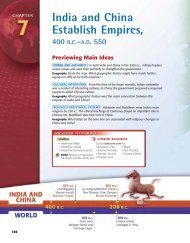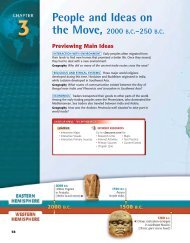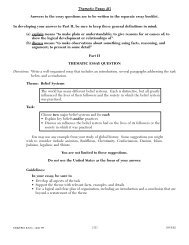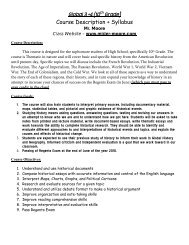The Industrial Revolution, 1700– 1900 Previewing Main Ideas
The Industrial Revolution, 1700– 1900 Previewing Main Ideas
The Industrial Revolution, 1700– 1900 Previewing Main Ideas
You also want an ePaper? Increase the reach of your titles
YUMPU automatically turns print PDFs into web optimized ePapers that Google loves.
Summarizing<br />
What were some of<br />
the important<br />
reform bills passed<br />
in Britain during<br />
this period?<br />
In 1847, the Parliament passed a bill that helped<br />
working women as well as their children. <strong>The</strong> Ten<br />
Hours Act of 1847 limited the workday to ten hours<br />
for women and children who worked in factories.<br />
Reformers in the United States also passed laws<br />
to protect child workers. In 1904, a group of progressive<br />
reformers organized the National Child<br />
Labor Committee to end child labor. Arguing that<br />
child labor lowered wages for all workers, union<br />
members joined the reformers. Together they pressured<br />
national and state politicians to ban child<br />
labor and set maximum working hours.<br />
In 1919, the U.S. Supreme Court objected to a<br />
federal child labor law, ruling that it interfered with<br />
states’ rights to regulate labor. However, individual<br />
states were allowed to limit the working hours of<br />
women and, later, of men.<br />
<strong>The</strong> Reform Movement Spreads<br />
Almost from the beginning, reform movements rose in response to the negative<br />
impact of industrialization. <strong>The</strong>se reforms included improving the workplace and<br />
extending the right to vote to working-class men. <strong>The</strong> same impulse toward reform,<br />
along with the ideals of the French <strong>Revolution</strong>, also helped to end slavery and promote<br />
new rights for women and children.<br />
<strong>The</strong> Abolition of Slavery William Wilberforce, a highly religious man, was a member<br />
of Parliament who led the fight for abolition—the end of the slave trade and slavery<br />
in the British Empire. Parliament passed a bill to end the slave trade in the British<br />
West Indies in 1807. After he retired from Parliament in 1825, Wilberforce continued<br />
his fight to free the slaves. Britain finally abolished slavery in its empire in 1833.<br />
British antislavery activists had mixed motives. Some, such as the abolitionist<br />
Wilberforce, were morally against slavery. Others viewed slave labor as an economic<br />
threat. Furthermore, a new class of industrialists developed who supported<br />
cheap labor rather than slave labor. <strong>The</strong>y soon gained power in Parliament.<br />
In the United States the movement to fulfill the promise of the Declaration of<br />
Independence by ending slavery grew in the early 1800s. <strong>The</strong> enslavement of<br />
African people finally ended in the United States when the Union won the Civil<br />
War in 1865. <strong>The</strong>n, enslavement persisted in the Americas only in Puerto Rico,<br />
Cuba, and Brazil. In Puerto Rico, slavery was ended in 1873. Spain finally abolished<br />
slavery in its Cuban colony in 1886. Not until 1888 did Brazil’s huge<br />
enslaved population win freedom.<br />
<strong>The</strong> Fight for Women’s Rights <strong>The</strong> <strong>Industrial</strong> <strong>Revolution</strong> proved a mixed blessing<br />
for women. On the one hand, factory work offered higher wages than work<br />
done at home. Women spinners in Manchester, for example, earned much more<br />
money than women who stayed home to spin cotton thread. On the other hand,<br />
women factory workers usually made only one-third as much money as men did.<br />
Women led reform movements to address this and other pressing social issues.<br />
During the mid-1800s, for example, women formed unions in the trades where they<br />
dominated. In Britain, some women served as safety inspectors in factories where<br />
other women worked. In the United States, college-educated women like Jane<br />
Addams ran settlement houses. <strong>The</strong>se community centers served the poor residents<br />
of slum neighborhoods.<br />
▲ Hungarian<br />
workers meet<br />
to plan their<br />
strategy before<br />
a strike.<br />
<strong>The</strong> <strong>Industrial</strong> <strong>Revolution</strong> 739
















